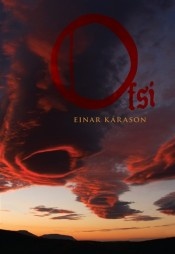The best of times, the worst of times
Einar Kárason's historical novel Fury draws on a tumultuous period in Icelandic history. A German translation appeared in February.
 The 13th century was one of the most colorful periods in Icelandic history, and the bloodiest. “The Age of the Sturlungs”, named after the most powerful clan of the period and originally described in the Saga of the Sturlungs, was at once a golden era of literature and a time of violent conflict.
The 13th century was one of the most colorful periods in Icelandic history, and the bloodiest. “The Age of the Sturlungs”, named after the most powerful clan of the period and originally described in the Saga of the Sturlungs, was at once a golden era of literature and a time of violent conflict.
Einar Kárason's historical novel Ofsi (Fury) draws on this tumultuous period. The book, a free-standing sequel to Einar's Óvinafagnaður (A Gathering of Foes), was first published in Icelandic in 2008, and is due to appear in German in February.
The book describes the build-up to one of the most infamous and heinous events of The Saga of the Sturlungs, The Flugumýri Arson, during which scores of people burned to death inside the farm of the chieftain Gissur Þorvaldsson. Gissur himself, however, famously escaped the flames unscathed by submerging himself in a barrel of whey.
Although some members of the warring factions attempted to stem the tide of bloodshed, their attempts at reconciliations were ineffectual in the face of the era's obsession with honor and blood feud, and all negotiations inevitably flared up into continuing violence, as Fury relates.
The narrative of the original Saga of the Sturlungs is matter-of-fact and objective, leaving much of the motives, feelings and experiences of its characters open to speculation. In Fury, however, Einar uses the framework of the historical novel to fill in these blanks, offering his readers a glimpse into the minds of the men and women of this remote and cataclysmic age.
Fury received the Icelandic Literary Prize in 2008 and proved a hit with Icelandic readers. An unexpected side-effect of its popularity was that interest in the original Saga of the Sturlungs was rekindled, causing it to quickly sell out and become unobtainable in book stores.
We had a chat with Einar about the upcoming German translation, and the reservations Icelandic authors often have about delving into their literary inheritance.
Tragedy and betrayal, folly and cowardice
 How are Fury and A Gathering of Foes connected, and how are they different?
How are Fury and A Gathering of Foes connected, and how are they different?
They're connected in that they both take place in the same era of Icelandic history – they revolve around dramatic events in a civil war that lasted for decades. Their action takes place about ten to fifteen years apart, and they share some minor characters. But A Gathering of Foes is largely a tale of suspense and heroism, while Fury is more concerned with tragedy and betrayal, folly and cowardice.”
The narrative voice in Fury is very distinctive and employs a method from Faulkner's As I Lay Dying. What made you choose this way of telling the story?
“I used to wonder about the differences between the two major categories of novels: the first-person narratives, and the third-person narratives told by an omniscient voice who observes everything and can relate many simultaneous events. While there are advantages to each method, there are also disadvantages, so I looked for an alternative. The authors of the sagas – including the Saga of the Sturlungs, which is my main source for the books – used third-person narrative and never went inside the heads of their characters. So the inner narrative voice seemed to be an untilled field. And by using Faulkner's brilliant method – the polyphonic narrative – I was free from the constraints of one single viewpoint.
Icelandic novelists seem to have reservations about tackling the sagas. Did you have to adopt a special approach when you began work on Fury?
“Only in that I have infinite respect and admiration for these ancient works of art. This inescapably gives you reservations – you can't ever mess up, can't ever be trite or banal. Long after I began working on the book, I had doubts whether the outcome would be good enough to survive the inevitable comparison with the original works. So whatever respect or reservations I had hopefully encouraged hard work and diligence!
What is the difference between the world of the Sagas of the Icelanders and the Saga of the Sturlungs?
The Sagas of the Icelanders mostly take place in the years during and around the settlement of Iceland – from early 9th century to early 11th – but they were probably written in the 13th century – almost 300 years later. The Saga of the Sturlungs was written around the same period, but unlike the Sagas of the Icelanders, it relates contemporary events, major and minor happenings that the authors of the work were often directly involved in.
Therein lies the difference: In the Sagas of the Icelanders, the intervening centuries between the events and the writing erase all minor events and characters. The dust settles, the fog and smoke is blown away. Only heroes and major events remain, bathed in a cold, crisp light.
The Saga of the Sturlungs, on the other hand, includes everything. It's a jumble of protagonists, pivotal characters and thousands of minor figures with little or no influence on the plot. Momentous events are mixed in with wholly insignificant ones, and sometimes it's hard follow the story. But that's how it is in real life, too. You suddenly find yourself in a crowd of strangers, caught up in a chain of events you don't understand, and you need to figure out for yourself which people of all these multitudes are going to be part of your story, which of the countless subplots are going to have any lasting significance.”
Related content:
For more on The Saga of the Sturlungs, click here to see our video interview with the farmer Sigurður Hansen, who, using 111 boulders and a power-shovel, has meticulously recreated one of the most notorious battles in Icelandic history.
